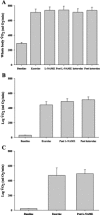Roles of nitric oxide synthase and cyclooxygenase in leg vasodilation and oxygen consumption during prolonged low-intensity exercise in untrained humans
- PMID: 20558755
- PMCID: PMC3774514
- DOI: 10.1152/japplphysiol.00326.2010
Roles of nitric oxide synthase and cyclooxygenase in leg vasodilation and oxygen consumption during prolonged low-intensity exercise in untrained humans
Abstract
The vasodilator signals regulating muscle blood flow during exercise are unclear. We tested the hypothesis that in young adults leg muscle vasodilation during steady-state exercise would be reduced independently by sequential pharmacological inhibition of nitric oxide synthase (NOS) and cyclooxygenase (COX) with NG-nitro-L-arginine methyl ester (L-NAME) and ketorolac, respectively. We tested a second hypothesis that NOS and COX inhibition would increase leg oxygen consumption (VO2) based on the reported inhibition of mitochondrial respiration by nitric oxide. In 13 young adults, we measured heart rate (ECG), blood pressure (femoral venous and arterial catheters), blood gases, and venous oxygen saturation (indwelling femoral venous oximeter) during prolonged (25 min) steady-state dynamic knee extension exercise (60 kick/min, 19 W). Leg blood flow (LBF) was determined by Doppler ultrasound of the femoral artery. Whole body VO2 was measured, and leg VO2 was calculated from blood gases and LBF. Resting intra-arterial infusions of acetylcholine (ACh) and nitroprusside (NTP) tested inhibitor efficacy. Leg vascular conductance (LVC) to ACh was reduced up to 53±4% by L-NAME+ketorolac infusion, and the LVC responses to NTP were unaltered. Exercise increased LVC from 4±1 to 33.1±2 ml.min(-1).mmHg(-1) and tended to decrease after L-NAME infusion (31±2 ml.min(-1).mmHg(-1), P=0.09). With subsequent administration of ketorolac LVC decreased to 29.6±2 ml.min(-1).mmHg(-1) (P=0.02; n=9). While exercise continued, LVC returned to control values (33±2 ml.min(-1).mmHg(-1)) within 3 min, suggesting involvement of additional vasodilator mechanisms. In four additional subjects, LVC tended to decrease with L-NAME infusion alone (P=0.08) but did not demonstrate the transient recovery. Whole body and leg VO2 increased with exercise but were not altered by L-NAME or L-NAME+ketorolac. These data indicate a modest role for NOS- and COX-mediated vasodilation in the leg of exercising humans during prolonged steady-state exercise, which can be restored acutely. Furthermore, NOS and COX do not appear to influence muscle VO2 in untrained healthy young adults.
Figures





Similar articles
-
Combined inhibition of nitric oxide and vasodilating prostaglandins abolishes forearm vasodilatation to systemic hypoxia in healthy humans.J Physiol. 2011 Apr 15;589(Pt 8):1979-90. doi: 10.1113/jphysiol.2011.205013. Epub 2011 Feb 21. J Physiol. 2011. PMID: 21486803 Free PMC article. Clinical Trial.
-
Impaired acetylcholine-induced cutaneous vasodilation in young smokers: roles of nitric oxide and prostanoids.Am J Physiol Heart Circ Physiol. 2013 Mar 1;304(5):H667-73. doi: 10.1152/ajpheart.00731.2012. Epub 2013 Jan 11. Am J Physiol Heart Circ Physiol. 2013. PMID: 23316063 Free PMC article. Clinical Trial.
-
Prostaglandins do not contribute to the nitric oxide-mediated compensatory vasodilation in hypoperfused exercising muscle.Am J Physiol Heart Circ Physiol. 2011 Jul;301(1):H261-8. doi: 10.1152/ajpheart.00222.2011. Epub 2011 May 2. Am J Physiol Heart Circ Physiol. 2011. PMID: 21536852 Free PMC article.
-
Local inhibition of nitric oxide and prostaglandins independently reduces forearm exercise hyperaemia in humans.J Physiol. 2004 Jun 1;557(Pt 2):599-611. doi: 10.1113/jphysiol.2004.061283. Epub 2004 Mar 26. J Physiol. 2004. PMID: 15047770 Free PMC article.
-
Muscle blood flow, hypoxia, and hypoperfusion.J Appl Physiol (1985). 2014 Apr 1;116(7):852-7. doi: 10.1152/japplphysiol.00620.2013. Epub 2013 Jul 25. J Appl Physiol (1985). 2014. PMID: 23887898 Free PMC article. Review.
Cited by
-
TNF signals via neuronal-type nitric oxide synthase and reactive oxygen species to depress specific force of skeletal muscle.J Appl Physiol (1985). 2013 Jun;114(11):1629-36. doi: 10.1152/japplphysiol.00871.2012. Epub 2013 Apr 4. J Appl Physiol (1985). 2013. PMID: 23558387 Free PMC article.
-
Rapid-onset vasodilator responses to exercise in humans: Effect of increased baseline blood flow.Exp Physiol. 2020 Jan;105(1):88-95. doi: 10.1113/EP088227. Epub 2019 Dec 19. Exp Physiol. 2020. PMID: 31762131 Free PMC article.
-
Augmented skeletal muscle hyperaemia during hypoxic exercise in humans is blunted by combined inhibition of nitric oxide and vasodilating prostaglandins.J Physiol. 2011 Jul 15;589(Pt 14):3671-83. doi: 10.1113/jphysiol.2011.209486. Epub 2011 May 30. J Physiol. 2011. PMID: 21624968 Free PMC article.
-
Prostaglandins induce vasodilatation of the microvasculature during muscle contraction and induce vasodilatation independent of adenosine.J Physiol. 2014 Mar 15;592(6):1267-81. doi: 10.1113/jphysiol.2013.264259. Epub 2014 Jan 27. J Physiol. 2014. PMID: 24469074 Free PMC article.
-
Effects of chronic nitric oxide synthase inhibition on V'O2max and exercise capacity in mice.Naunyn Schmiedebergs Arch Pharmacol. 2017 Mar;390(3):235-244. doi: 10.1007/s00210-016-1318-3. Epub 2016 Dec 3. Naunyn Schmiedebergs Arch Pharmacol. 2017. PMID: 27915453
References
-
- Bernstein RD, Ochoa FY, Xu X, Forfia P, Shen W, Thompson CI, Hintze TH. Function and production of nitric oxide in the coronary circulation of the conscious dog during exercise. Circ Res 79: 840–848, 1996 - PubMed
-
- Bradley SJ, Kingwell BA, McConell GK. Nitric oxide synthase inhibition reduces leg glucose uptake but not blood flow during dynamic exercise in humans. Diabetes 48: 1815–1821, 1999 - PubMed
-
- DeLorey DS, Hamann JJ, Kluess HA, Clifford PS, Buckwalter JB. Alpha-adrenergic receptor-mediated restraint of skeletal muscle blood flow during prolonged exercise. J Appl Physiol 100: 1563–1568, 2006 - PubMed
Publication types
MeSH terms
Substances
Grants and funding
LinkOut - more resources
Full Text Sources
Medical
Miscellaneous

